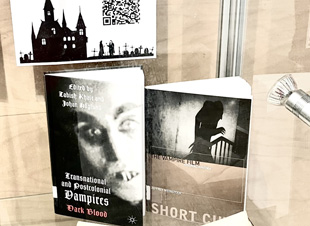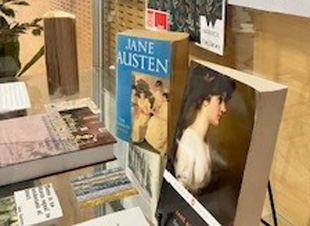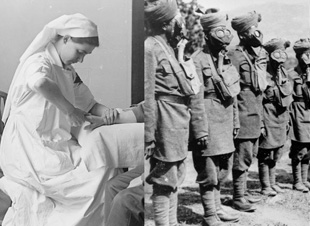Rare books - previous exhibitions
We regularly showcase exhibitions in the cabinet located near the lifts on floor 1. You can see our previous exhibitions and online details below.
This exhibition highlights LGBTUA+ authors and histories through its extensive print and online collections. Featuring craft output from the Community Engagement pride event held in June 2023.
This exhibition highlights LGBTUA+ authors and histories through its extensive print and online collections. Featuring craft output from the Community Engagement pride event held in June 2023.
As an English Literature student with a passion for all things Gothic, I’ve always been particularly interested in Vampires, arguably one of the most Gothic literary figures out there!
"I find their representation in both folklore and modern day media fascinating, as there is quite a stark contrast from tales about terrifying bloodsuckers told centuries ago around a campfire, to the romanticised versions we see so often today on our screens, for example in the Twilight Saga.
I am also extremely interested in how this vampiric figure appears in different cultures all around the globe. How have cultures from such varying locations all found some kind of evidence of Vampires? Can there be any truth to the tales, seeing as similar stories originate from many places at once?
This display provides some excellent examples of Vampire literature and other related media. I hope that you find something interesting to read, watch or find out more about!
I really enjoyed creating this display, as it allowed me to learn more about Vampires, and what vampiric belief looks like in varying cultures. I look forward to reading people’s contributions to the Padlet, to find out what stories they have heard about Vampires".
The goal for the display case was primarily to encourage people who don’t consider themselves readers to pick up reading for fun.
Short stories are a great place to start (or stay!) for those who don’t have the time to look for and commit to longer books. They’re perfect for picking up when you’re in the ‘in-between’ moments in your day like waiting for lectures, or even if you just want to relax for a few minutes without going straight to scrolling through social media.
The texts on display are from classic authors, many of whom are pioneering figures in their respective genres and can be read in less than a day.
Creating this display was a great experience that allowed me to reflect not just on how I personally interact with reading in my day-to-day life, but also how other people do as well, especially when in an academic environment that doesn’t allow much time for reading for pleasure. It also encouraged me to consider just how impactful and thought-provoking literature can be despite its length; something I hope other people will discover as well!
Exploration, Representation, & Education
Description from Nina G, a Library Associate
As an undergraduate pursuing an English Literature and Creative Writing degree at Warwick, I was faced with quite a few choices in modules heading into the 2020-21 academic year.
Approaching selection day, I noted a course which I had never heard about, nor thought would exist: 'Yiddish Literature in Translation'. As someone with both Ashkenazi and Sephardic Jewish heritage — the former designating those from Eastern Europe, while the latter those from the Iberian peninsula, Northern Africa, and the Middle East — I was drawn to this module that would later inspire my personal exploration of the communities, history, and literature of the Jewish diaspora.
This module focused upon Yiddish, the language of Eastern European Jews (Ashkenazi) which contains a significant foundation in Germanic languages, as well as influences from Russian, French, Hebrew and more. I studied Ashkenazi writers from all over the globe including Poland, Argentina, New York and London. It was incredibly interesting and I fell in love with knowing that works are still being discovered today. During the module I even noted certain quotes of great meaning to me, such as from the poetry of Avrom Sutskever:
“It matters not if I rise high or if I fall — The word is mine. In the pupil of death’s eye— a little flame,” - ‘To the Thin Artery in My Head’ (1945)
It was this exact idea of “the word” being something personal that struck a chord. Our words are most certainly our own, and we can channel anything we conjure into these very words. Inspired by this concept, I forged new imaginative paths within my own creative writing — from a story about the disembodied spirit of the Dybbuk, to a poem powered by Yiddish sayings I heard from my grandparents. However, more importantly, the works presented to us spoke to a crucial, ongoing conversation — restoration, revitalization, and preservation. Many of these writers wrote in Yiddish in order to not only save a dying language, but as a lifeline to Ashkenazi culture regardless of continent or country. These works were translated for the benefit of wider audiences, as well as inclusion into the wider scope of World Literature. Without translation it’s safe to say the world often wouldn’t be aware of the existence of these works and writers, similar to many other unique cultural groups that exist around the world.
I’ve tried explaining the concept of Spanish and Latin American Jews to many people in my life. It’s no easy task, as while a Jew who speaks Spanish implies a Sephardic background, the diaspora of Eastern European Jews into Central and South America means the presence of Ashkenazi backgrounds as well. It didn’t make much sense to people. 'Could there seriously be a language (Ladino) and a people that were a Judeo-Spanish mix?' In short, yes, and it’s fascinating! So here arises my “little flame” written on a Post-It-note:
As a Library Associate, I want to create a display case that showcases Sephardic literature and history.
If wider readership leads to the possibility of opening up literary windows, we must start with awareness. With approval from the library, my research into Sephardic culture and literature found a home. I located incredible narrative pieces from Mexican and Mexican-American writers such as Rosa Nissán, Kathleen Alcalá, and Angelina Muñiz-Huberman; to Cuban-American author, Ruth Behar; and Guatemalan-American author, Victor Perera. I even discovered that André Aciman, writer of the renowned book, 'Call Me By Your Name', was Sephardic and learned Ladino during his upbringing. I was again reminded of the importance of “the word” and how crucial it is for students to pursue projects of passion.
You may very well fear your work's unforeseen reception and harbor doubts, but better to be fearless and push ahead: write about it, talk about it, and share it with everyone you know because your stories, passions, and Post-It note ideas are always worth telling. While some may see little value in a small display case, it’s the oxygen which turned my “little flame” into a huge one.
I hope that the students, professors and visitors alike will see the display, coming away inspired and motivated to pursue their own projects…projects that represent the beautiful communities, little known as many may be, that exist within our university and the world at large.
This display was created by Daira Povez-Gamboa; one of the 22/23 cohort of Library Associates. The Library works in partnership with its students and offers varied opportunities for Library Associates to work creatively on projects they are passionate about.
“Jane Austen is one of the most iconic and influential writers of all time (and my favourite British author). Having her birthday on December 16th, I believed creating a display of her was a good way to commemorate her work.
It was an amazing and rewardable experience as I was able to share my passion for Jane Austen’s work with other students and It made me realised there are still some books of her that I have to read soon.”
The Global South Initiative is a call for solidarity, collaboration, empathy, and above all resistance. Resistance to divide the of the West and the rest, and all the discrimination which comes with it. We, scholars from all parts of the Global South, are resisting our invisibility in academia. We are here, and we bring our worlds with us, and we aim to claim our place in Academia.
To achieve this mission, the work of the Global South Initiative challenges structures, spaces, and language of traditional/colonial academia. It allows the formation of a non-hierarchical creative, and informal space where academics, intellectuals and everyone on campus with a thirst for critical knowledge , has a place where they can tell their stories and find a home away from home.
Celebrating 50 years since the 1st pride festival the Library highlighted LGBTUA+ authors and history through its extensive print and online collections.
The Grosseteste Press was founded in 1966, with John Riley and Tim Longville as editors. Publishing a range of small poetry collections, alongside the Grosseteste Review from 1968-1978, Grosseteste was an important addition to the UK small press scene.
Each publication was a “singular event”, designed not to fit into a house style but to reflect the content itself. Poetry with longer lines was printed in a landscape format, and new ways to produce work were created to most effectively present poetry and prose. Aimed at an “open-minded reader”, the press focussed on experimental poetry, short prose and translated poetry.
The Grosseteste Review was an established magazine by the end of its first year, but came to an abrupt end in 1978, after the murder of John Riley. Gr/ew books, an aspect of the press that began in 1972, continued until 1984, at which point Longville felt that the future of the small press world was bleak. “I’m tired”, he said to Michael Haslam. “Let some other bugger have a go.”
Despite his lack of confidence in the future of the small press, Grosseteste has remained a significant figure in the publications of the 1960s and ‘70s, printing a wide variety of influential and interesting work from the UK and US. One such writer was Martin Wright, also a member of the English Department at Warwick, who donated this collection to the Library. Further reading.
This display marked International Holocaust Remembrance Day 2022 with a focus on the experience of persecution by the Jewish community in occupied Europe during the Second World War as well as other minority communities persecuted by the Nazi’s.
The display drew from the Library’s collections and included historical descriptions and commentaries, personal experiences and reflection, as well as the representation of the Holocaust in the art of survivors, their descendants and wider culture, with survivor’s stories and remembrance at its centre.
Inspired by the magazines, newspapers and ephemera held in the Ethnicity and Migration Collection this exhibition explores how Black migrants celebrated, shared and made visible their cultures since the arrival of the Empire Windrush in 1948.
The realities of racial prejudice, discrimination and intolerance as a daily certainty of the Black British experience is also represented.
Curated by Warwick Undergraduates from History Module HI2D4 ‘Race, Ethnicity, and Migration’ in Modern Britain to coincide with Black History Month 2019.
France, the Jews and everyday life in the Second World War: from victimhood to agency

Curated by staff and students from the School of Modern Languages and Cultures.
Our fantastic new exhibition on Ergodic literature (literature that makes you work!), curated by MA student Izy Cowling, in the floor 1 display case.
By Espen Aarseth’s terms, a ‘non-ergodic’ piece of literature refers to any text where navigating is trivial and requires no more than moving your eyes and turning the pages.
Derived from the ancient Greek ‘ergon’ (work) and ‘hodos’ (path), Aarseth’s notion of ‘ergodic literature’ then, includes any text that requires extra effort to navigate the text.
This display exhibits texts that are experimental or unusual in their form, and so subvert the usual conventions of reading, or the expectations placed upon a reader. Some require the reader to rotate the book, use a mirror or a decoding wheel. Others have digital elements that require the reader to go online, or find clues within the collaged pages of an old Victorian novel.
To mark the centenary of the Armistice the Library has assembled a collection of literature, films, photographs and scholarship from the commencement of the First World War in 1914 to the present day.
The centenary has provided numerous opportunities to re-explore the realities of a war that has become embedded in our cultural memory and understanding of conflict. It has offered the occasion to recover stories which have started to fade or remained untold. This display contributes to this retelling and reflects upon the ways the First World War has been and continues to be remembered, retold and rediscovered.
This exhibition also commemorates the individuals from the thirty two countries involved. It pays tribute to those who made sacrifices of their time, families and lives to fight, support and, in some instances, resist the war. The sources included therefore, are as diverse as the individuals involved. Rather than telling their stories for them, this display hopes to encourage viewers to explore the multitude of voices, opinions and responses to the ’Great War’ beyond its centenary years.
Images: © IWM (Q 27817), © IWM (Q 56644), © IWM (Q 33687) (Under IWM Non-commercial licence). ‘First World War Official Photographs—South Africa, National Library of Scotland, (accessed 5 November 2018), CC-BY-NC-SA.
A sample from the collections
2018 has been a year of anniversaries, no less for British Black history. It is the 70th anniversary of the arrival of the Empire Windrush, the 60th of the Notting Hill race riots and 50th of Enoch Powell’s Rivers of Blood speech and the 1968 Race Relations Act.
This display is both a reflection and celebration of British Black history across these tumultuous years.
For Black History Month, the Library has selected material from the Ethnicity and Migration collection and the MRC’s Minority Art’s holdings.
This exhibit celebrates the Black communities and activists who rose up to provide support, refuge and carnival in the face of systematic racial injustice and persecution.
It simultaneously highlights, through contemporary journals, reports and images the discrimination, hostility and violence which fuelled Black resistance and determination for equality throughout the 60’s, 70’s and 80’s.
The Ethnicity and Migration collections can be found on Floor 5 of the Library.
2018 marks the fiftieth anniversary of events, which made 1968 an unforgettable year. Through the use of journalistic documents and art, this curated project aims to illustrate the extent of protest and social movement of that year by focusing on the international scale of unrest.
This exhibit includes news reports and photography from France, Italy, the USA, Japan and Eastern Europe, highlighting both the violent and political atmosphere, developing across the world during the course of this tumultuous year.
Artistic works are also presented in order to showcase how these movements inspired creative citizens to depict the 'revolutionary' period in innovate ways.
Along with the exhibition, Warwick commemorates this important anniversary with a conference taking place on May 19, which re-examines the legacy of 1968 and seeks to tell the stories of lesser known participants and activists.
Exhibition curated by Rebecca Infield and Mary Jane Dempsey, with help from Liz Wood (MRC) and Kate Courage and Lynn Wright (Library).
20 April - 2 May 2018
Peter Larkin
Howard Skempton
Simon Lewty
Poet Peter Larkin, composer Howard Skempton and visual artist Simon Lewty, all born in the 1940s, have lived and worked in the vicinity of the University of Warwick for decades. Although a web of correspondences links their compositions across different media, and although Larkin and Lewty have collaborated extensively in the past, no occasion so far has brought their work into common dialogue. This exhibit includes samples of Larkin’s poetry, Skempton’s music manuscripts and Lewty’s notebooks and graphic work as a means of highlighting the resonances and connections arising from a shared commitment to exploring the fundamentals of artistic process and expression. To acknowledge the auditory as well as visual dimension of these connections, the exhibit also features access to recordings of work by all three artists.
“Inscriptions: Image | Text | Sound” accompanies the symposium on the work of Peter Larkin taking place on April 26th at the University of Warwick.
View the collection online
This exhibition gives a flavour of early printing in Italy and England, from 1500-1699, as publishing shifted from scribe to printer, from parchment to paper, large books to small books, from few to many and from Latin to vernacular.
Italy led the way, with Italian books being exported all over Europe by the 16th century. Early printing in England, after the reformation, mostly produced Bibles and the new Book of Common Prayer. This expanded rapidly in the late 17th century to cover a range of topics, with elaborate illustrations and in a variety of formats. These aimed to attract both popular readers and land owners keen to build up their private libraries.
The exhibition shows a sample of the Library's small but fascinating special collection of early printed books, bought in the 1960s, from the private libraries of Edmund Hutton and Roberto Weiss.
Email View the collection online

















